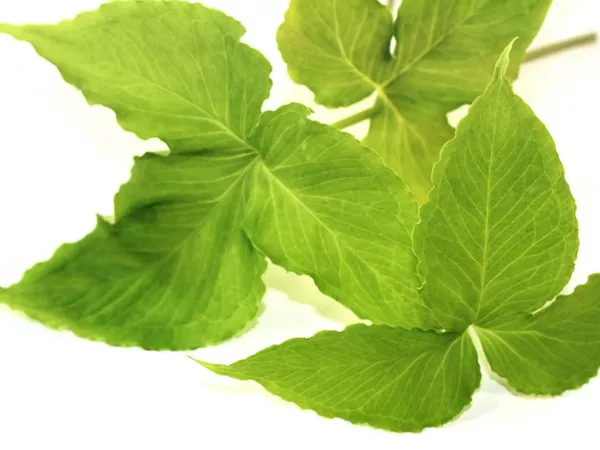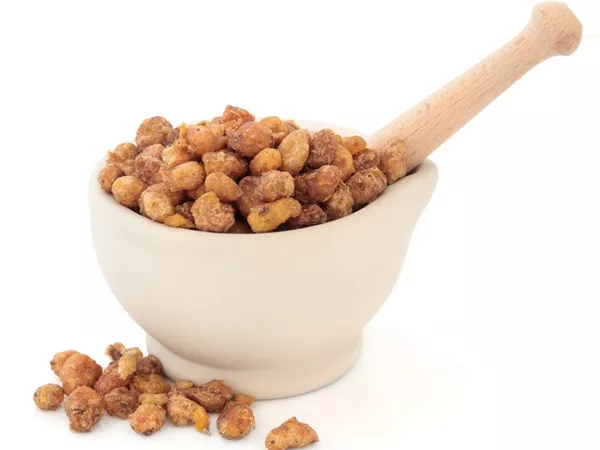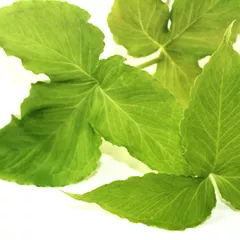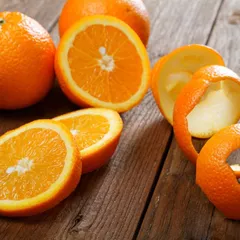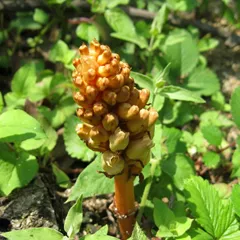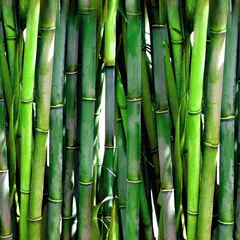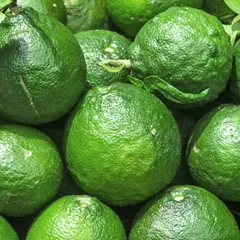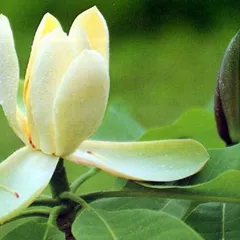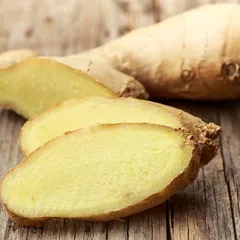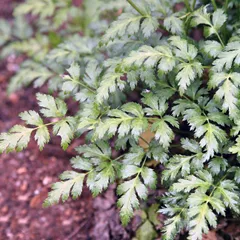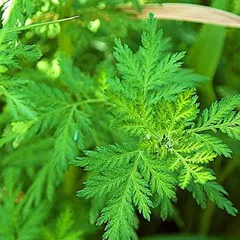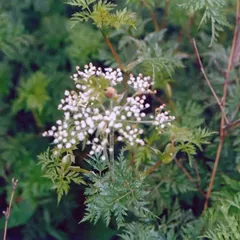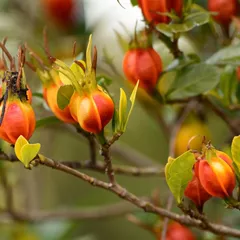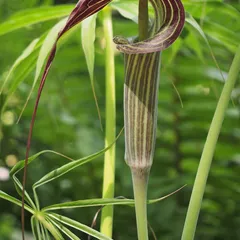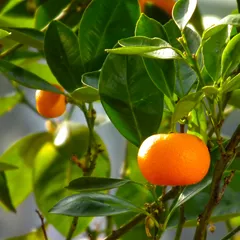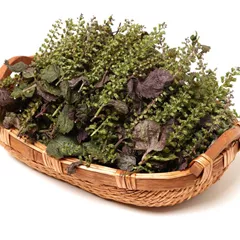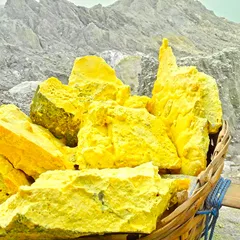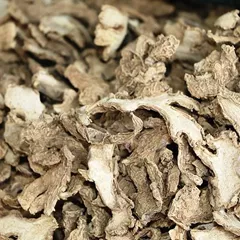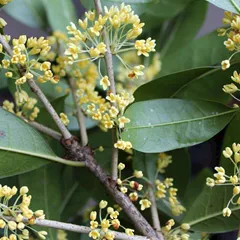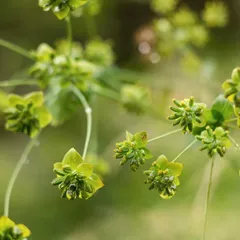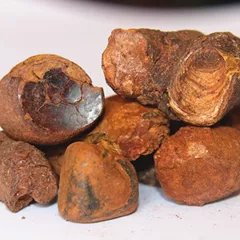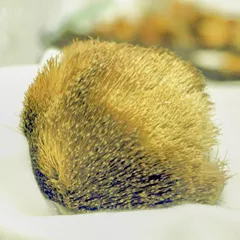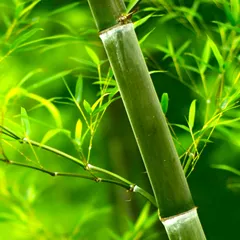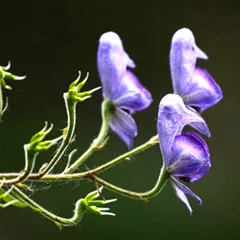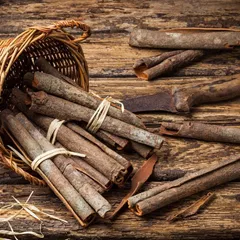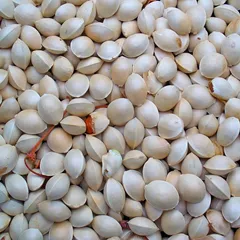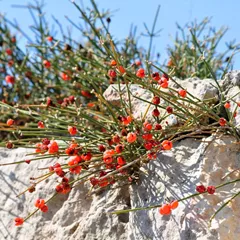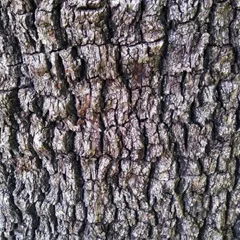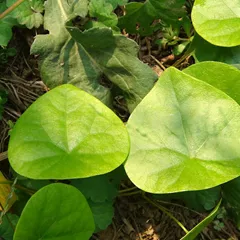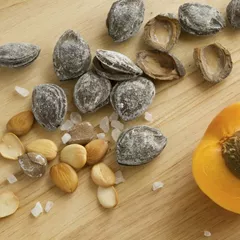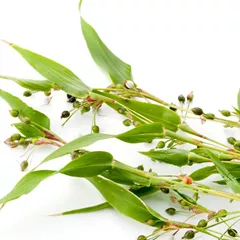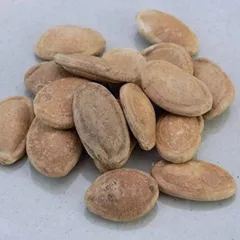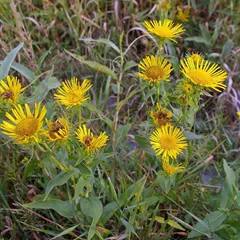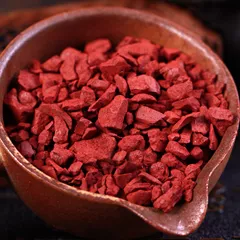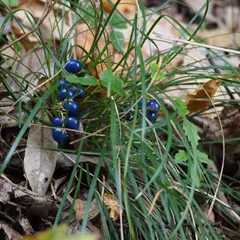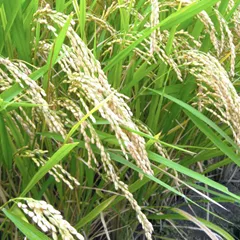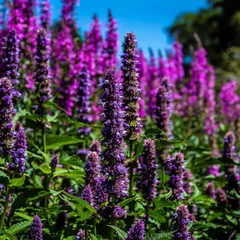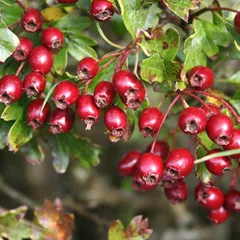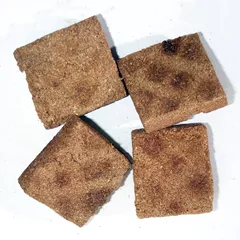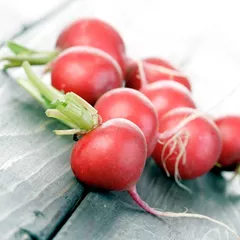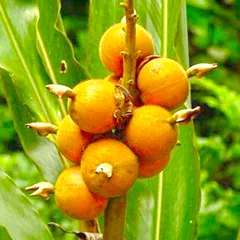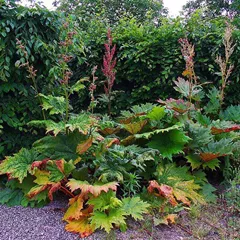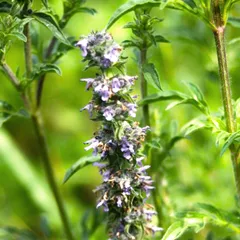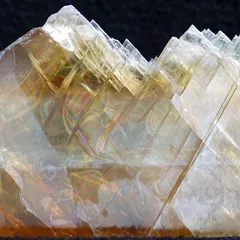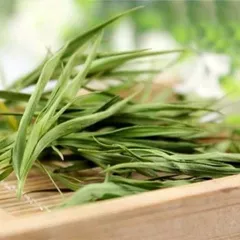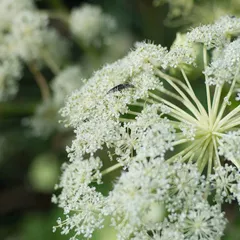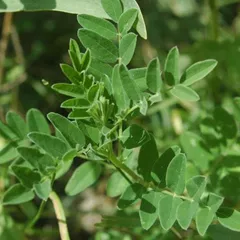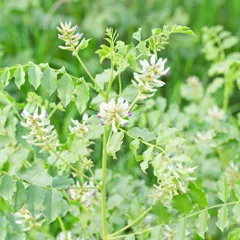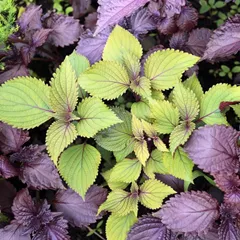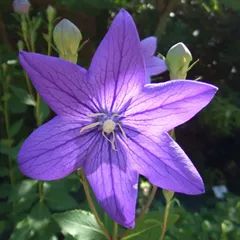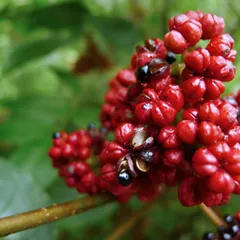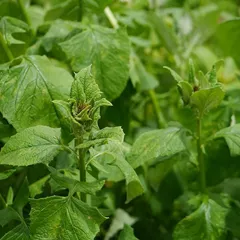Use of Ban Xia (crow-dipper rhizomes) in TCM
Please note that you should never self-prescribe TCM ingredients. A TCM ingredient is almost never eaten on its own but as part of a formula containing several ingredients that act together. Please consult a professional TCM practitioner, they will be best able to guide you.
Preparation: Because the raw unprocessed herb is toxic, it is most often given in its processed form which is fried with Ginger juice.
Dosage: 3 - 12 grams
Main actions according to TCM*: Drains Dampness and reduces Phlegm. Reverses the flow of Rebellious Qi. Reduces hardenings and relieves distention.
Primary conditions or symptoms for which Ban Xia may be prescribed by TCM doctors*: Asthma Coughing Phlegm Sputum Palpitations Headache Morning sickness Globus pharyngis Chest congestion
Contraindications*: This herb is toxic in its raw form so it should only be taken if processed by a professional. This herb should not be used by pregnant women or those with any blood disorders, especially bleeding. It should be used with caution by those with Heat and Dryness. This herb should not be used with Aconite (Fu Zi).
Common TCM formulas in which Ban Xia is used*
Er Chen Tang
Source date: 1148 AD
Number of ingredients: 5 herbs
Formula key actions: Dries Damp and dispels Phlegm. Regulates Qi and harmonizes the Middle Burner (Stomach and Spleen).
Conditions targeted*: Upper respiratory tract infectionsChronic bronchitis and others
Ban Xia is a king ingredient in Er Chen Tang. Like the name indicates, it means it has more power than other ingredients in the formula.
In Er Chen Tang, Ban Xia dries Dampness, expels Phlegm, and causes rebellious Qi in the Stomach to descend. As a single ingredient, it provides most of the actions required in treating a Phlegm-Dampness pattern.
Ban Xia Bai Zhu Tian Ma Tang
Source date: 1732 AD
Number of ingredients: 8 herbs
Formula key actions: Dries and dissolves Phlegm. Strengthens the Spleen. Smoothes the Liver and calms Liver Wind (antispasmodic).
Conditions targeted*: Meniere's diseaseHypertension and others
Ban Xia is a king ingredient in Ban Xia Bai Zhu Tian Ma Tang. Like the name indicates, it means it has more power than other ingredients in the formula.
In Ban Xia Bai Zhu Tian Ma Tang, Ban Xia dries Dampness, transforms Phlegm, and directs Rebellious Qi downward (to treat the nausea and vomiting).
Wen Dan Tang
Source date: 1174 AD
Number of ingredients: 8 herbs
Formula key actions: Clears Phlegm. Clears Gallbladder. Regulates Qi. Harmonizes the Stomach.
Conditions targeted*: HypertensionAngina and others
Ban Xia is a king ingredient in Wen Dan Tang. Like the name indicates, it means it has more power than other ingredients in the formula.
In Wen Dan Tang, Ban Xia is the principal substance in the materia medica for transforming Phlegm and regulating the Stomach Qi.
Ban Xia Hou Pu Tang
Source date: 220 AD
Number of ingredients: 5 herbs
Formula key actions: Regulates the flow of Qi, treats esophageal spasm. Clears Phlegm.
Conditions targeted*: Globus hystericusNeurosis and others
Ban Xia is a king ingredient in Ban Xia Hou Pu Tang. Like the name indicates, it means it has more power than other ingredients in the formula.
In Ban Xia Hou Pu Tang, Ban Xia transforms Phlegm, dissipates clumps, directs Rebellious Qi downward, and harmonizes the Stomach. It thereby addresses all the major aspects of Phlegm-Qi.
Xiao Ban Xia Tang
Source date: 220 AD
Number of ingredients: 2 herbs
Formula key actions: Alleviates and removes thin mucus. Directs rebellious Qi downward. Stops vomiting. Harmonizes the Stomach.
Conditions targeted*: Travel sickness and others
Ban Xia is a king ingredient in Xiao Ban Xia Tang. Like the name indicates, it means it has more power than other ingredients in the formula.
In Xiao Ban Xia Tang, Ban Xia is acrid, drying, and downward-directing. It drains water and Dampness by drying and dispersing them. Through its ability to direct the Qi downward, it harmonizes the Stomach and stops nausea, hiccup, and a sensation of fullness in the epigastrium.
Huang Lian Wen Dan Tang
Source date: 1852 AD
Number of ingredients: 7 herbs
Formula key actions: Clears Hot Phlegm. Clears Gallbladder Heat. Regulates Qi. Harmonizes the Stomach.
Conditions targeted*: HypertensionAngina and others
Ban Xia is a king ingredient in Huang Lian Wen Dan Tang. Like the name indicates, it means it has more power than other ingredients in the formula.
In Huang Lian Wen Dan Tang, Ban Xia is the principal substance in the materia medica for transforming Phlegm and regulating the Stomach Qi.
Hao Qin Qing Dan Tang
Source date: Qing Dynasty
Number of ingredients: 10 herbs
Formula key actions: Clears Heat and relieves acute conditions of the Gallbladder. Relieves acute Damp-Heat syndromes. Resolves Phlegm. Harmonizes the Stomach.
Conditions targeted*: CholecystitisIcteric hepatitis and others
Ban Xia is a deputy ingredient in Hao Qin Qing Dan Tang. This means it helps the king ingredient(s) treat the main pattern or it serves to treat a coexisting pattern.
In Hao Qin Qing Dan Tang, Ban Xia , together with Bitter orange and Tangerine peel (Chen Pi), other deputies of this formula, drains Gallbladder and Stomach Heat, directs rebellious Qi downward, harmonizes the Stomach, and transforms Phlegm.
Ban Xia Xie Xin Tang
Source date: 220 AD
Number of ingredients: 7 herbs
Formula key actions: Reverses the flow of Rebellious Stomach Qi. Relieves both Heat and Cold Stagnation in the gastrointestinal tract.
Conditions targeted*: Peptic ulcersGastroesophageal reflux disease and others
Ban Xia is a deputy ingredient in Ban Xia Xie Xin Tang. This means it helps the king ingredient(s) treat the main pattern or it serves to treat a coexisting pattern.
In Ban Xia Xie Xin Tang, Ban Xia enters the Stomach Channel and disperses clumping, stops vomiting, and eliminates focal distention.
Xiong Gui Er Chen Tang
Source date: 1575 AD
Number of ingredients: 7 herbs
Formula key actions: Resolves Damp-Phlegm. Nourishes Blood.
Ban Xia is a deputy ingredient in Xiong Gui Er Chen Tang. This means it helps the king ingredient(s) treat the main pattern or it serves to treat a coexisting pattern.
In Xiong Gui Er Chen Tang, Ban Xia dries Dampness, expels phlegm, and causes rebellious Stomach Qi to descend. This latest action makes it also useful in controlling nausea and vomiting.
Its main purpose is to open the Qi dynamic. As noted by Zhang Shan-Lei the best aspects of Ban Xia can be summed up in four characters: opening (开 kai), disseminating(宣 xuan), slippery (滑 hua), and downward-directing (降 jiang). The reason that it can eliminate turbidity and Phlegm is simply its actions in opening, draining, and slipping downward.
The transformation of Phlegm by Ban Xia facilitates the smooth flow of Qi. Once this occurs, the transporting and transforming functions of the Spleen and Stomach will be restored. Then the Middle Burner will no longer produce Phlegm.
Lian Po Yin
Source date: 1862 AD
Number of ingredients: 7 herbs
Formula key actions: Clears Heat. Transforms Dampness. Regulates Qi. Harmonizes the Middle Burner.
Conditions targeted*: GastroenteritisTyphoid and others
Ban Xia is a deputy ingredient in Lian Po Yin. This means it helps the king ingredient(s) treat the main pattern or it serves to treat a coexisting pattern.
In Lian Po Yin, Ban Xia dries Dampness and is very effective in directing the Rebellious Stomach Qi downward, thereby stopping vomiting and/or nausea
Di Tan Tang
Source date: 1470 AD
Number of ingredients: 9 herbs
Formula key actions: Removes Phlegm. Opens the sensory orifices. Tonifies Qi.
Conditions targeted*: Cerebrovascular accidentSeizure disorder and others
Ban Xia is a deputy ingredient in Di Tan Tang. This means it helps the king ingredient(s) treat the main pattern or it serves to treat a coexisting pattern.
In Di Tan Tang, Ban Xia acrid and warming. It is good at drying Dampness and transforming Phlegm. It also directs the rebellious Qi downward and warms the Stomach.
Su Zi Jiang Qi Tang
Source date: 650 AD
Number of ingredients: 8 herbs
Formula key actions: Directs rebellious Qi downward. Arrests wheezing. Stops coughing. Warms and transforms Phlegm-Cold.
Conditions targeted*: Chronic bronchitisEmphysema and others
Ban Xia is a deputy ingredient in Su Zi Jiang Qi Tang. This means it helps the king ingredient(s) treat the main pattern or it serves to treat a coexisting pattern.
In Su Zi Jiang Qi Tang, Ban Xia helps the key herb in directing Qi downward and transforming Phlegm
Ban Liu Wan
Source date: 1107
Number of ingredients: 3 herbs
Formula key actions: Fortifies the Fire at the Gate of Vitality. Expels Cold. Unblocks the Yang. Drains Turbidity.
Conditions targeted*: Constipation in the elderlyChronic diarrhea and others
Ban Xia is a deputy ingredient in Ban Liu Wan. This means it helps the king ingredient(s) treat the main pattern or it serves to treat a coexisting pattern.
In Ban Liu Wan, Ban Xia is acrid and warm, which harmonizes the Stomach, and descends Qi. It is also bitter, which dries turbid Yin.
It thereby focuses the action of the key herb on the Yang
Brightness.
Huang Lian Tang
Source date: 220 AD
Number of ingredients: 7 herbs
Formula key actions: Regulates Cold and Heat. Harmonizes the Stomach. Directs Rebellious Qi downward.
Conditions targeted*: GastritisHyperacidic stomach and others
Ban Xia is a deputy ingredient in Huang Lian Tang. This means it helps the king ingredient(s) treat the main pattern or it serves to treat a coexisting pattern.
In Huang Lian Tang, Ban Xia is acrid and warm. It plalys a role of harmonizing the Stomach by directing Rebellious Qi downward to stop nausea and vomiting. It also expands the chest and removes Stagnation to reduce focal distention.
Qing Pi Tang
Source date: 1253 AD
Number of ingredients: 9 herbs
Formula key actions: Harmonizes and resolves. Transforms Phlegm and dries Dampness. Improves the Spleen's transportive function. Clears Heat. Moves Qi.
Conditions targeted*: Malaria and others
Ban Xia is a deputy ingredient in Qing Pi Tang. This means it helps the king ingredient(s) treat the main pattern or it serves to treat a coexisting pattern.
In Qing Pi Tang, Ban Xia dries the dampness and transforms the phlegm, and thus opens the Qi dynamic to facilitate the venting of the pathogen.
Hui Chun Dan
Source date: Late 18th century
Number of ingredients: 19 herbs
Formula key actions: Opens the sensory orifices. Arrests spasms and convulsions. Clears Heat and transforms Phlegm.
Conditions targeted*: Acute encephalitisAcute meningitis and others
Ban Xia is a deputy ingredient in Hui Chun Dan. This means it helps the king ingredient(s) treat the main pattern or it serves to treat a coexisting pattern.
In Hui Chun Dan, Ban Xia redirects Rebellious Qi downward and stops the vomiting.
Hui Yang Jiu Ji Tang
Source date: 1445 AD
Number of ingredients: 11 herbs
Formula key actions: Restores and revives the Yang. Augments the Qi. Revives the pulse.
Conditions targeted*: Myocardial infarctionCardiogenic shock and others
Ban Xia is a deputy ingredient in Hui Yang Jiu Ji Tang. This means it helps the king ingredient(s) treat the main pattern or it serves to treat a coexisting pattern.
In Hui Yang Jiu Ji Tang, Ban Xia reverses the flow of Rebellious Qi.
Liu Jun Zi Tang
Source date: 1107
Number of ingredients: 6 herbs
Formula key actions: Tonifies Qi. Strengthens the Spleen and Stomach. Clears Phlegm and mucus. Promotes appetite.
Conditions targeted*: AnorexiaPeptic ulcers and others
Ban Xia is an assistant ingredient in Liu Jun Zi Tang. This means that it either serves to reinforces the effect of other ingredients or it moderates their toxicity.
In Liu Jun Zi Tang, Ban Xia , like Tangerine Peel (Chen Pi), has a drying effect and helps direct the Qi downward.
Ding Chuan Tang
Source date: 1550 AD
Number of ingredients: 9 herbs
Formula key actions: Clears Lung Heat. Expectorant for asthma.
Conditions targeted*: Chronic bronchitisAsthma and others
Ban Xia is an assistant ingredient in Ding Chuan Tang. This means that it either serves to reinforces the effect of other ingredients or it moderates their toxicity.
Xiao Xian Xiong Tang
Source date: 220 AD
Number of ingredients: 3 herbs
Formula key actions: Clears Heat. Transforms Phlegm. Expands the chest. Dissipates clumps.
Conditions targeted*: HepatitisCholecystitis and others
Ban Xia is an assistant ingredient in Xiao Xian Xiong Tang. This means that it either serves to reinforces the effect of other ingredients or it moderates their toxicity.
In Xiao Xian Xiong Tang, Ban Xia is very effective in directing the Rebellious Qi downward, harmonizing the Stomach, transforming Phlegm, eliminating focal distention, and dissipating clumps.
Together Snake gourd - the key herb in this formula - it is excellent for treating focal distention of the chest and diaphragm due to clumping of Phlegm and Heat, or for painful obstruction of the chest due to clumping of sticky and thick Phlegm.
Together with Goldthread rhizome - the deputy herb in this formula - it treats the obstruction caused by Phlegm-Heat by utilizing their combination of bitter, downward-directing, and acrid opening natures.
Xuan Bi Tang
Source date: 1798 AD
Number of ingredients: 9 herbs
Formula key actions: Clears and resolves Damp-Heat. Unblocks the meridians. Disbands painful obstruction.
Conditions targeted*: Rheumatic feverRheumatoid arthritis and others
Ban Xia is an assistant ingredient in Xuan Bi Tang. This means that it either serves to reinforces the effect of other ingredients or it moderates their toxicity.
In Xuan Bi Tang, Ban Xia dries Dampness and transforms turbidity.
Qing Qi Hua Tan Wan
Source date: 1584 AD
Number of ingredients: 8 herbs
Formula key actions: Clears Heat. Transforms Phlegm. Directs Rebellious Qi downwards. Stops coughing.
Conditions targeted*: PneumoniaChronic bronchitis and others
Ban Xia is an assistant ingredient in Qing Qi Hua Tan Wan. This means that it either serves to reinforces the effect of other ingredients or it moderates their toxicity.
In Qing Qi Hua Tan Wan, Ban Xia strongly assists the key ingredient (Arisaema with bile) in expelling the Phlegm that has already formed.
Xiao Chai Hu Tang
Source date: 220 AD
Number of ingredients: 7 herbs
Formula key actions: Treats the Lesser Yang Channels (Gallbladder and Triple Warmer). Regulates the Liver and Spleen functions. Addresses combined Yin-Yang symptoms of External and Internal, Excess and Deficiency, and Hot and Cold.
Conditions targeted*: HepatitisChronic cholecystitis and others
Ban Xia is an assistant ingredient in Xiao Chai Hu Tang. This means that it either serves to reinforces the effect of other ingredients or it moderates their toxicity.
In Xiao Chai Hu Tang, Ban Xia warms and transforms Phlegm and turbidity in the Middle Burner.
When combined with another assistant herb in this formula, Fresh Ginger (Sheng Jiang), it harmonizes the Middle Burner, directs Rebellious Qi downward, and stops nausea and vomiting.
Xuan Fu Dai Zhe Tang
Source date: 220 AD
Number of ingredients: 7 herbs
Formula key actions: Regulates the downward flow of Stomach Qi. Expectorant, treats hiccups.
Conditions targeted*: HiccupsChronic gastritis and others
Ban Xia is an assistant ingredient in Xuan Fu Dai Zhe Tang. This means that it either serves to reinforces the effect of other ingredients or it moderates their toxicity.
In Xuan Fu Dai Zhe Tang, Ban Xia works together with Fresh ginger (Sheng Jiang), another assistant herb here, to warm and harmonize the Stomach and direct Qi downward, thereby dispelling the Phlegm and dispersing the focal distention.
Xiao Qing Long Tang
Source date: 220 AD
Number of ingredients: 8 herbs
Formula key actions: Releases the Exterior. Transforms Phlegm-Fluids. Warms the Lungs. Directs Rebellious Qi downward.
Conditions targeted*: Upper respiratory tract infectionsBronchitis and others
Ban Xia is an assistant ingredient in Xiao Qing Long Tang. This means that it either serves to reinforces the effect of other ingredients or it moderates their toxicity.
In Xiao Qing Long Tang, Ban Xia transforms Phlegm-Fluids and harmonizes the Stomach.
Mai Men Dong Tang
Source date: 220 AD
Number of ingredients: 6 herbs
Formula key actions: Nourishes the Stomach. Generates Body Fluids. Directs Rebellious Qi downward.
Conditions targeted*: Lung atrophyLaryngitis and others
Ban Xia is an assistant ingredient in Mai Men Dong Tang. This means that it either serves to reinforces the effect of other ingredients or it moderates their toxicity.
In Mai Men Dong Tang, Ban Xia facilitates the Stomach Qi flow and guides the Qi downward. The warm, acrid, drying nature of this herb is moderated by the moistening herbs in the formula and by its relatively low dosage. In fact, adding a small amount of this acrid, dispersing herb to the formula will assist in the distribution of nourishment from the Middle Burner to the Upper Burner, and redirect the Qi, thereby facilitating the replenishment of Body Fluids in the Lungs.
Huo Xiang Zheng Qi San
Source date: 1107 AD
Number of ingredients: 11 herbs
Formula key actions: Releases the Exterior. Transforms Dampness. Regulates Qi. Harmonizes the Middle Burner.
Conditions targeted*: GastroenteritisStomach flu and others
Ban Xia is an assistant ingredient in Huo Xiang Zheng Qi San. This means that it either serves to reinforces the effect of other ingredients or it moderates their toxicity.
In Huo Xiang Zheng Qi San, Ban Xia harmonizes the Stomach and stops the vomiting.
Bao He Wan
Source date: 1481 AD
Number of ingredients: 7 herbs
Formula key actions: Reduces food stagnation. Harmonizes the Stomach.
Conditions targeted*: GastroenteritisChronic gastritis and others
Ban Xia is an assistant ingredient in Bao He Wan. This means that it either serves to reinforces the effect of other ingredients or it moderates their toxicity.
In Bao He Wan, Ban Xia promotes the movement of Qi and transform stagnation, thereby harmonizing the Stomach to stop the nausea and vomiting
San Ren Tang
Source date: 1798 AD
Number of ingredients: 8 herbs
Formula key actions: Clears Damp-Heat. Disseminates the Qi. Facilitates the Qi mechanisms.
Conditions targeted*: TyphoidPyelonephritis and others
Ban Xia is an assistant ingredient in San Ren Tang. This means that it either serves to reinforces the effect of other ingredients or it moderates their toxicity.
In San Ren Tang, Ban Xia treats epigastric and abdominal distention due to Dampness or Phlegm
Da Chai Hu Tang
Source date: 220 AD
Number of ingredients: 8 herbs
Formula key actions: Harmonizes and releases the Lesser Yang. Drains internal clumping due to Heat.
Conditions targeted*: CholecystitisCholelithiasis and others
Ban Xia is an assistant ingredient in Da Chai Hu Tang. This means that it either serves to reinforces the effect of other ingredients or it moderates their toxicity.
In Da Chai Hu Tang, Ban Xia harmonizes the Middle Burner and directs the Rebellious Stomach Qi
downward. Together with one of the envoys, Fresh ginger, it can stop vomiting effectively.
Jin Fei Cao San
Source date: 1107 AD
Number of ingredients: 9 herbs
Formula key actions: Disperses Wind-Cold. Descends Lung Qi. Transform Phlegm . Stop cough and calms wheezing .
Conditions targeted*: Common coldInfluenza and others
Ban Xia is an assistant ingredient in Jin Fei Cao San. This means that it either serves to reinforces the effect of other ingredients or it moderates their toxicity.
In Jin Fei Cao San, Ban Xia transforms Phlegm, dries Dampness, descends Qi and relieves the cough.
Chai Hu Jia Long Gu Mu Li Tang
Source date: 220 AD
Number of ingredients: 12 herbs
Formula key actions: Unblocks the three Yang warps. Sedates and calms the Spirit.
Conditions targeted*: NeurosisDepression and others
Ban Xia is an assistant ingredient in Chai Hu Jia Long Gu Mu Li Tang. This means that it either serves to reinforces the effect of other ingredients or it moderates their toxicity.
In Chai Hu Jia Long Gu Mu Li Tang, Ban Xia causes the Qi to descend. It works with Poria-cocos mushrooms for transforming the disturbances of the Body Fluids and for openening up the diaphragm.
It also assists Bupleurum root and Baikal skullcap root in resolving the Lesser Yang warp aspects of this disorder.
Zhu Ye Shi Gao Tang
Source date: 220 AD
Number of ingredients: 7 herbs
Formula key actions: Clears Heat. Generates Body Fluids. Strengthens and regulates Qi.
Conditions targeted*: PneumoniaEncephalitis B and others
Ban Xia is an assistant ingredient in Zhu Ye Shi Gao Tang. This means that it either serves to reinforces the effect of other ingredients or it moderates their toxicity.
In Zhu Ye Shi Gao Tang, Ban Xia directs rebellious Qi downward and thereby stops the vomiting.
It is a warm and acrid herb and may therefore appear to be inappropriate in this formula. However, in concert with the Heat-clearing and Fluid-generating ingredients, it invigorates the Spleen Qi and reduces the Stagnation properties of Dwarf lilyturf root.
Wu Ji San
Source date: 846 AD
Number of ingredients: 15 herbs
Formula key actions: Releases the Exterior. Warms the Interior. Smoothes the flow of Qi. Transforms Phlegm. Invigorates the Blood. Reduces Stagnation.
Conditions targeted*: BronchiolitisSciatica and others
Ban Xia is an assistant ingredient in Wu Ji San. This means that it either serves to reinforces the effect of other ingredients or it moderates their toxicity.
In Wu Ji San, Ban Xia strengthens the Spleen and transform Phlegm.
Sheng Yang Yi Wei Tang
Source date: 1247 AD
Number of ingredients: 16 herbs
Formula key actions: Strengthens the Spleen. Augments the Qi. Raises the Yang. Releases Dampness.
Conditions targeted*: Atrophic gastritisChronic pelvic inflammatory disease and others
Ban Xia is an assistant ingredient in Sheng Yang Yi Wei Tang. This means that it either serves to reinforces the effect of other ingredients or it moderates their toxicity.
In Sheng Yang Yi Wei Tang, Ban Xia , like Tangerine Peel (Chen Pi), has a drying effect and helps direct the Qi downward.
Xing Su San
Source date: 1798 AD
Number of ingredients: 11 herbs
Formula key actions: Clears Dry-Cold. Disseminates the Lung Qi and relieves cough. Transforms thin mucus.
Conditions targeted*: Common coldBronchitis and others
Wen Jing Tang
Source date: 220 AD
Number of ingredients: 12 herbs
Formula key actions: Warms the Uterus and vessels. Nourishes Blood. Dispels Cold. Dispels Blood Stagnation.
Conditions targeted*: Dysfunctional uterine bleedingUterine hypoplasia and others
In Wen Jing Tang, Ban Xia tonifies Qi and harmonizes the Spleen and Stomach to strengthen the source of production and transformation so that Yang can produce Yin and the Blood may not be Deficient. It also harmonizes the Uterus via the Stomach channel to which it is connected through the Penetrating Meridian.
Xiang Sha Liu Jun Zi Tang
Source date: 1675 AD
Number of ingredients: 9 herbs
Formula key actions: Tonifies Spleen and Stomach Qi. Removes Dampness. Moves Qi. Alleviates pain.
In Xiang Sha Liu Jun Zi Tang, Ban Xia , like Tangerine Peel (Chen Pi), has a drying effect and helps direct the Qi downward. It also stops nausea.
Xiang Sha Yang Wei Wan
Source date: 1587 AD
Number of ingredients: 13 herbs
Formula key actions: Strengthens and harmonizes the Spleen and Stomach. Resolves Dampness.
Conditions targeted*: Poor appetiteLoss of taste and others
In Xiang Sha Yang Wei Wan, Ban Xia strengthens the Spleen by removing the Dampness.
Key TCM concepts behind Ban Xia's properties
In Traditional Chinese Medicine (TCM), Ban Xia belongs to the 'Warm herbs that transform Phlegm and stop Cough' category. In TCM Phlegm is a condition of Stagnation of Fluids which tends to start in the Spleen and then goes to the Lungs. If this overly accumulates it thickens and becomes pathological Phlegm. Phlegm, being a form of Stagnation, often starts as being Cool and transforms to Hot as the condition progresses. The herbs in this category are Warm in nature so they treat the early stages of the Stagnation: Cold-Phlegm and Wet-Phlegm with symptoms of wheezing, vomiting and nausea.
As suggested by its category Ban Xia is Warm in nature. This means that Ban Xia tends to help people who have too much 'Cold' in their body, although with less effect than a plant that would be Hot in nature. Balance between Yin and Yang is a key health concept in TCM. Those who have too much Cold in their body are said to either have a Yin Excess (because Yin is Cold in nature) or a Yang Deficiency (Yang is Hot in Nature). Depending on your condition Ban Xia can help restore a harmonious balance between Yin and Yang.
Ban Xia also tastes Pungent. The so-called 'Five Phases' theory in Chinese Medicine states that the taste of TCM ingredients is a key determinant of their action in the body. Pungent ingredients like Ban Xia tends to promote the circulations of Qi and Body Fluids. That's why for instance someone tends to sweat a lot when they eat spicy/pungent food.
The tastes of ingredients in TCM also determine what Organs and Meridians they target. As such Ban Xia is thought to target the Lung, the Spleen and the Stomach. In addition to performing respiration, the Lungs are thought in TCM to be a key part of the production chain for Qi and the Body Fluids that nourish the body. The Spleen on the other hand assists with digestion, Blood coagulation and Fluids metabolism in the body. The Stomach is responsible for receiving and ripening ingested food and fluids. It is also tasked with descending the digested elements downwards to the Small Intestine.
Research on Ban Xia
The herbal medicine TJ-109 (consisting of Pinellia tuber) effectively reduced the incidence of acute tonsillitis. 1
Tracheitis Plaster (consisting of Pinellia tuber) is a highly effective transcutaneous absorbent with promising long-term effect and could regulate the immune function.2
Sources:
1. Goto F, Asama Y, Ogawa K. (2010). Sho-saiko-to-ka-kikyo-sekko as an alternative treatment for chronic tonsillitis to avoid surgery. Complement Ther Clin Pract. , 16(4):216-8. doi: 10.1016/j.ctcp.2010.02.006. Epub 2010 Mar 19.
2. Huo GR, Ma LQ, Huang CH. (2001). Clinical study on treatment of chronic bronchitis by tracheitis plaster. Zhongguo Zhong Xi Yi Jie He Za Zhi, 21(11):816-8.

